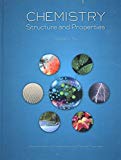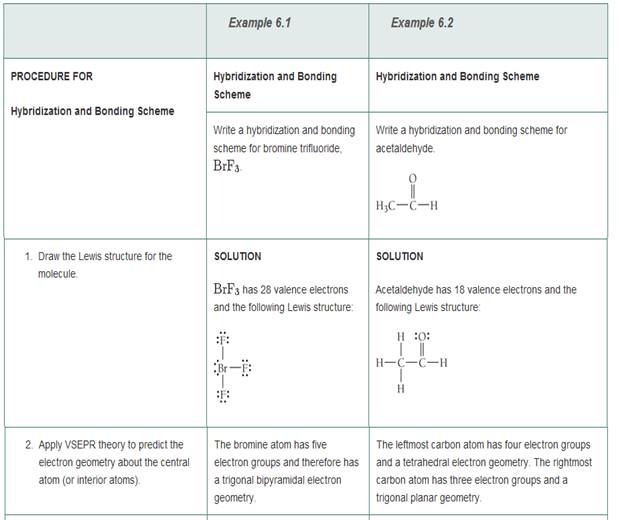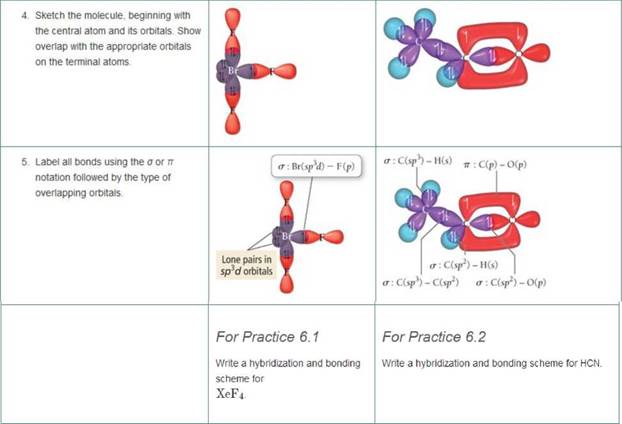
Chemistry: Structure and Properties Custom Edition for Rutgers University General Chemistry
15th Edition
ISBN: 9781269935678
Author: Nivaldo J. Tro
Publisher: Pearson Education
expand_more
expand_more
format_list_bulleted
Textbook Question
Chapter 7, Problem 42E
Write a hybridization and bonding scheme for each molecule or ion. Sketch the structure, including overlapping orbitals, and label all bonds using the notation shown in Examples 6.1 and 6.2
- SO32-
- PF6-
- BrF3
- HCN



Expert Solution & Answer
Want to see the full answer?
Check out a sample textbook solution
Students have asked these similar questions
PLEASE HELP! URGENT!
"Water gas" is an industrial fuel composed of a mixture of carbon monoxide and hydrogen gases. When this
fuel is burned, carbon dioxide and water result. From the information given below, write a balanced equation
and determine the enthalpy of this reaction:
CO(g) + O2(g) → CO₂(g) + 282.8 kJ
H2(g) + O2(g) → H₂O(g) + 241.8 kJ
MacBook Air
Page of 3
4. Calculate AG for the following reaction at 25°C. Will the reaction occur (be spontaneous)? How do you
know?
NH3(g) + HCl(g) → NH4Cl(s)
AH=-176.0 kJ
AS-284.8 J-K-1
Chapter 7 Solutions
Chemistry: Structure and Properties Custom Edition for Rutgers University General Chemistry
Ch. 7 - Determine the hybridization about 0 in CH3OH.Ch. 7 - Determine the hybridization about C in H2CO.Ch. 7 - According to the valance bond theory, which kind...Ch. 7 - Use molecular orbital theory to determine the bond...Ch. 7 - Use molecular orbital theory to predict which...Ch. 7 - Use molecular orbital theory to determine which...Ch. 7 - Which hybridization scheme occurs about nitrogen...Ch. 7 - Prob. 8SAQCh. 7 - Prob. 9SAQCh. 7 - Prob. 10SAQ
Ch. 7 - Which type of orbitals overlap to form the sigma...Ch. 7 - Prob. 12SAQCh. 7 - Prob. 1ECh. 7 - What is a chemical bond according to valence bond...Ch. 7 - In valence bond theory, what determines the...Ch. 7 - In valence bond theory, the interaction energy...Ch. 7 - What is hybridization? Why is hybridization...Ch. 7 - How does hybridization of the atomic orbitals in...Ch. 7 - How is the number of hybrid orbitals related to...Ch. 7 - Sketch each hybrid orbital sp sp2 sp3 sp3d sp3d2Ch. 7 - Prob. 9ECh. 7 - Name the hybridization scheme that corresponds to...Ch. 7 - What is a chemical bond according to molecular...Ch. 7 - Explain the difference between hybrid atomic...Ch. 7 - What is a bonding molecular orbital?Ch. 7 - Prob. 14ECh. 7 - What is the role of wave interference in...Ch. 7 - Prob. 16ECh. 7 - Prob. 17ECh. 7 - Prob. 18ECh. 7 - Prob. 19ECh. 7 - Prob. 20ECh. 7 - Prob. 21ECh. 7 - When applying molecular orbital theory to...Ch. 7 - In molecular orbital theory, what is a nonbonding...Ch. 7 - Write a short paragraph describing chemical...Ch. 7 - Prob. 25ECh. 7 - Prob. 26ECh. 7 - Prob. 27ECh. 7 - Prob. 28ECh. 7 - Prob. 29ECh. 7 - Prob. 30ECh. 7 - The valence electron configurations of several...Ch. 7 - The valence electron configurations of several...Ch. 7 - Draw orbital diagrams (boxes with arrows in them)...Ch. 7 - Draw orbital diagrams (boxes with arrows in them)...Ch. 7 - Prob. 35ECh. 7 - Draw orbital diagrams (boxes with arrows in them)...Ch. 7 - Which hybridization scheme allows the formation of...Ch. 7 - Which hybridization scheme allows the central atom...Ch. 7 - Write a hybridization and bonding scheme for each...Ch. 7 - Write a hybridization and bonding scheme for each...Ch. 7 - Write a hybridization and bonding scheme for each...Ch. 7 - Write a hybridization and bonding scheme for each...Ch. 7 - Write a hybridization and bonding scheme for each...Ch. 7 - Write a hybridization and bonding scheme for each...Ch. 7 - Consider the structure of the amino acid alanine...Ch. 7 - Consider the structure of the amino acid aspartic...Ch. 7 - Sketch the bonding molecular orbital that results...Ch. 7 - Sketch the antibonding molecular orbital that...Ch. 7 - Draw an MO energy diagram and predict the bond...Ch. 7 - Draw an MO energy diagram and predict the bond...Ch. 7 - Sketch the bonding and antibonding molecular...Ch. 7 - Sketch the bonding and antibonding molecular...Ch. 7 - Using the molecular orbital energy ordenng for...Ch. 7 - Using the molecular orbital energy ordering for...Ch. 7 - Apply molecular orbital theory to predict if each...Ch. 7 - Apply molecular orbital theory to predict if each...Ch. 7 - According to MO theory, which molecule or ion has...Ch. 7 - According to MO theory, which molecule or ion has...Ch. 7 - Draw an MO energy diagram for CO. (Use the energy...Ch. 7 - Draw an MO energy diagram for HCI. Predict the...Ch. 7 - Prob. 61ECh. 7 - Prob. 62ECh. 7 - Prob. 63ECh. 7 - Prob. 64ECh. 7 - Prob. 65ECh. 7 - Prob. 66ECh. 7 - For each compound, draw the Lewis structure,...Ch. 7 - For each compound, draw the Lewis structure,...Ch. 7 - Amino acids are biological compounds that link...Ch. 7 - The genetic code is based on four different bases...Ch. 7 - The structure of caffeine, present in coffee and...Ch. 7 - The structure of acetylsalicylic acid (aspirin) is...Ch. 7 - Draw a molecular orbital energy diagram for CIF....Ch. 7 - Draw Lewis structures and MO diagrams for CN+, CN,...Ch. 7 - Bromine can form compounds or ions with any number...Ch. 7 - The compound C3H4 has two double bonds. Describe...Ch. 7 - How many hybrid orbitals do we use to describe...Ch. 7 - Prob. 78ECh. 7 - In VSEPR theory, which uses the Lewis model to...Ch. 7 - The resuts of a molecular orbital calculation for...Ch. 7 - Prob. 81ECh. 7 - cis-2-Butene isomerizes (changes its structure) to...Ch. 7 - The ion CH5 + can form under very special...Ch. 7 - Neither the VSEPR model nor the hybridization...Ch. 7 - Prob. 85ECh. 7 - The most stable forms of the nonmetals in groups...Ch. 7 - Consider the bond energies of three iodine...Ch. 7 - How many atomic orbitals form a set of sp3hybrid...
Knowledge Booster
Learn more about
Need a deep-dive on the concept behind this application? Look no further. Learn more about this topic, chemistry and related others by exploring similar questions and additional content below.Similar questions
- true or false The equilibrium constant for this reaction is 0.20. N2O4(g) ⇔ 2NO2(g) Based on the above, the equilibrium constant for the following reaction is 5. 4NO2(g) ⇔ 2N2O4(g)arrow_forwardtrue or false The equilibrium constant for this reaction is 0.20. N2O4(g) ⇔ 2NO2(g) Based on the above, the equilibrium constant for the following reaction is 0.4. 2N2O4(g) ⇔ 4NO2(g)arrow_forwardtrue or false Using the following equilibrium, if heat is added the equilibrium will shift toward the reactants. N2(g) + 3H2(g) ⇔ 2NH3(g) + heatarrow_forward
- True or False Using the following equilibrium, if heat is added the equilibrium will shift toward the products. N2O4(g) + heat ⇔ 2NO2(g)arrow_forwardtrue or false Using the following equilibrium, if solid carbon is added the equilibrium will shift toward the products. C(s) + CO2(g) ⇔ 2CO(g)arrow_forwardProvide the complete mechanism for the reaction below. You must include appropriate arrows,intermediates, and formal charges. Please also provide a reason to explain why the 1,4-adduct is preferred over the 1,3-adduct.arrow_forward
- Which of the following pairs are resonance structures of one another? I. III. || III IV + II. :0: n P !༠ IV. EN: Narrow_forwardPredict the major organic product(s) and byproducts (either organic or inorganic) for thefollowing reactions.arrow_forwardA 8.25 g sample of aluminum at 55°C released 2500 J of heat. The specific heat of aluminum is 0.900 J/g°C. The density of aluminum is 2.70 g/mL. Calculate the final temperature of the aluminum sample in °C.arrow_forward
arrow_back_ios
SEE MORE QUESTIONS
arrow_forward_ios
Recommended textbooks for you
 Chemistry: Principles and ReactionsChemistryISBN:9781305079373Author:William L. Masterton, Cecile N. HurleyPublisher:Cengage Learning
Chemistry: Principles and ReactionsChemistryISBN:9781305079373Author:William L. Masterton, Cecile N. HurleyPublisher:Cengage Learning Chemistry: Principles and PracticeChemistryISBN:9780534420123Author:Daniel L. Reger, Scott R. Goode, David W. Ball, Edward MercerPublisher:Cengage Learning
Chemistry: Principles and PracticeChemistryISBN:9780534420123Author:Daniel L. Reger, Scott R. Goode, David W. Ball, Edward MercerPublisher:Cengage Learning
 ChemistryChemistryISBN:9781305957404Author:Steven S. Zumdahl, Susan A. Zumdahl, Donald J. DeCostePublisher:Cengage Learning
ChemistryChemistryISBN:9781305957404Author:Steven S. Zumdahl, Susan A. Zumdahl, Donald J. DeCostePublisher:Cengage Learning Chemistry: An Atoms First ApproachChemistryISBN:9781305079243Author:Steven S. Zumdahl, Susan A. ZumdahlPublisher:Cengage Learning
Chemistry: An Atoms First ApproachChemistryISBN:9781305079243Author:Steven S. Zumdahl, Susan A. ZumdahlPublisher:Cengage Learning Chemistry for Engineering StudentsChemistryISBN:9781337398909Author:Lawrence S. Brown, Tom HolmePublisher:Cengage Learning
Chemistry for Engineering StudentsChemistryISBN:9781337398909Author:Lawrence S. Brown, Tom HolmePublisher:Cengage Learning

Chemistry: Principles and Reactions
Chemistry
ISBN:9781305079373
Author:William L. Masterton, Cecile N. Hurley
Publisher:Cengage Learning

Chemistry: Principles and Practice
Chemistry
ISBN:9780534420123
Author:Daniel L. Reger, Scott R. Goode, David W. Ball, Edward Mercer
Publisher:Cengage Learning


Chemistry
Chemistry
ISBN:9781305957404
Author:Steven S. Zumdahl, Susan A. Zumdahl, Donald J. DeCoste
Publisher:Cengage Learning

Chemistry: An Atoms First Approach
Chemistry
ISBN:9781305079243
Author:Steven S. Zumdahl, Susan A. Zumdahl
Publisher:Cengage Learning

Chemistry for Engineering Students
Chemistry
ISBN:9781337398909
Author:Lawrence S. Brown, Tom Holme
Publisher:Cengage Learning
Linear Combination of Atomic Orbitals LCAO; Author: Edmerls;https://www.youtube.com/watch?v=nq1zwrAIr4c;License: Standard YouTube License, CC-BY
Quantum Molecular Orbital Theory (PChem Lecture: LCAO and gerade ungerade orbitals); Author: Prof Melko;https://www.youtube.com/watch?v=l59CGEstSGU;License: Standard YouTube License, CC-BY